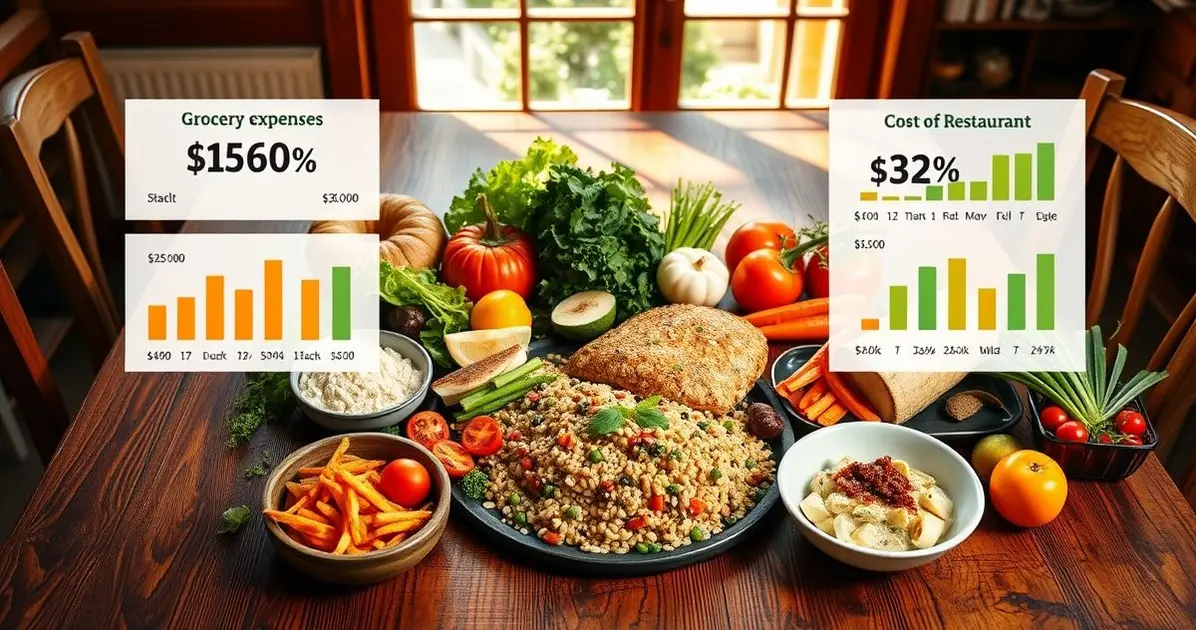Cooking at home is not only a delicious way to enjoy meals, but it also significantly cuts down on food expenses. By creating homemade dishes, families can save money while enjoying healthier options.
How cooking at home saves money

Preparing meals at home allows individuals to take control of their grocery budget, reducing food waste and minimizing the costs associated with dining out. Cooking at home maximizes value and promotes healthier eating habits, ultimately saving you money.
Cost Savings of Home-Cooked Meals
One of the most significant advantages of cooking at home is the substantial cost savings associated with home-cooked meals. Here’s a closer look at how preparing your own meals can help you save money:
1. Lower Ingredient Costs: When you cook at home, you have the flexibility to choose your ingredients based on price and availability. Purchasing raw ingredients, such as vegetables, grains, and proteins, is often cheaper than buying pre-prepared meals or takeout. Additionally, buying in bulk can lead to even greater savings.
2. Elimination of Restaurant Markups: Dining out comes with a significant markup on food prices. Restaurants charge for not only the ingredients but also labor, overhead, and profit margins. By cooking at home, you bypass these costs, allowing you to enjoy meals at a fraction of the price.
3. Portion Control: Home cooking allows you to control portion sizes, which can lead to less food waste. Restaurants often serve larger portions than necessary, leading to uneaten food that gets thrown away. Preparing meals at home means you can make just the right amount, helping you save money and reduce waste.
4. Flexibility in Meal Choices: Cooking at home gives you the freedom to choose budget-friendly recipes that fit your financial situation. You can plan meals around sales, seasonal produce, or pantry staples, ensuring that you make the most of your grocery budget.
5. Savings on Beverages: When dining out, beverages can significantly increase your bill, especially alcoholic drinks. By cooking at home, you can enjoy meals without the added costs of drinks, or you can choose to make your own beverages for a fraction of the price.
In conclusion, the cost savings of home-cooked meals are substantial and multifaceted. By preparing your own food, you not only save money but also gain control over what you eat, making it a win-win situation for both your wallet and your health.
Benefits of Buying Ingredients in Bulk
Buying ingredients in bulk offers numerous benefits that can help you save money and enhance your cooking experience. Here are some key advantages:
1. Cost Savings: One of the most significant benefits of buying in bulk is the potential for cost savings. Bulk items are often sold at a lower price per unit compared to their packaged counterparts. This means that purchasing larger quantities can lead to substantial savings over time.
2. Reduced Packaging Waste: Purchasing items in bulk typically results in less packaging waste. Many bulk items are sold without the excessive plastic or cardboard packaging that often accompanies single-serving products. This is not only better for your wallet but also for the environment.
3. Stocking Up on Essentials: Buying in bulk allows you to stock up on essential ingredients that you frequently use, such as grains, beans, spices, and cooking oils. Having these staples on hand means you can prepare a variety of meals without needing to make frequent trips to the grocery store.
4. Flexibility in Meal Planning: When you buy ingredients in bulk, you have the flexibility to experiment with different recipes and meal ideas. With a well-stocked pantry, you can easily adapt your meal plans based on what you have available, reducing the likelihood of last-minute takeout orders.
5. Longer Shelf Life: Many bulk items, such as dried beans, rice, and pasta, have a long shelf life when stored properly. This means you can purchase these items in larger quantities without worrying about them spoiling quickly. Just be sure to store them in airtight containers to maintain freshness.
6. Community and Local Support: Buying in bulk can also support local businesses and farmers, especially if you choose to purchase from local co-ops or farmers’ markets. This not only helps the local economy but often provides fresher, higher-quality ingredients.
In summary, the benefits of buying ingredients in bulk extend beyond mere cost savings. By purchasing in larger quantities, you can enjoy reduced packaging waste, stock up on essentials, and gain flexibility in your meal planning, all while supporting local sources and making environmentally friendly choices.

Meal Planning and Portion Control to Reduce Waste
Meal planning and portion control are essential strategies for reducing food waste in the kitchen while also saving money. Here’s how these practices can help you make the most of your ingredients:
1. Effective Meal Planning: Meal planning involves organizing your meals for the week, which can help you make informed decisions about what to cook and how much to buy. By planning your meals, you can create a shopping list that focuses on the ingredients you need, reducing impulse purchases and minimizing the likelihood of food going unused.
2. Utilizing Ingredients Wisely: When you plan your meals, you can ensure that you use similar ingredients across multiple dishes. This not only helps you save money but also reduces the chances of leftover ingredients spoiling before you have a chance to use them. For example, if you buy a bunch of spinach, you can use it in salads, soups, and stir-fries throughout the week.
3. Portion Control: Understanding portion sizes is crucial for reducing waste. By serving appropriate portions, you can prevent excess food from being left on plates and ultimately thrown away. Familiarize yourself with standard serving sizes and adjust them based on your household’s needs to ensure that everyone is satisfied without over-serving.
4. Leftover Management: Incorporating leftovers into your meal planning can significantly reduce waste. Plan for leftover meals by intentionally cooking larger portions or by using leftover ingredients in creative ways. For instance, leftover roasted chicken can be used in salads, sandwiches, or soups, ensuring that nothing goes to waste.
5. Freezing for Later: If you find that you have excess food that you can’t use in time, consider freezing it for later. Many ingredients, like vegetables, fruits, and cooked meals, can be frozen and enjoyed at a later date. This not only helps you save money but also ensures that you have convenient meal options on hand.
6. Regular Inventory Checks: Conducting regular inventory checks of your pantry and refrigerator can help you keep track of what you have and what needs to be used soon. This practice can inform your meal planning and help you avoid buying duplicates of ingredients you already have.
In summary, meal planning and portion control are powerful tools for reducing food waste and maximizing your grocery budget. By organizing your meals, utilizing ingredients wisely, managing portions, and creatively using leftovers, you can create a more sustainable kitchen that benefits both your wallet and the environment.
Healthier Ingredients for Long-Term Savings
Using healthier ingredients in your cooking not only contributes to better nutrition but can also lead to long-term savings in various ways. Here’s how incorporating nutritious options can benefit both your health and your wallet:
1. Preventing Chronic Diseases: A diet rich in whole, nutritious foods can help prevent chronic diseases such as obesity, diabetes, and heart disease. By investing in healthier ingredients, you may reduce your long-term healthcare costs associated with managing these conditions.
2. Reducing Medical Expenses: Eating a balanced diet filled with fruits, vegetables, whole grains, and lean proteins can lead to better overall health. This can translate into fewer doctor visits, lower prescription costs, and reduced medical bills, ultimately saving you money in the long run.
3. Improved Energy Levels: Healthier ingredients can provide the nutrients your body needs to function optimally, leading to increased energy levels and productivity. When you feel better, you may find that you are more active and engaged, which can lead to a healthier lifestyle and reduced healthcare costs.
4. Budget-Friendly Whole Foods: Many whole foods, such as beans, lentils, grains, and seasonal fruits and vegetables, are often more affordable than processed foods. By focusing on these budget-friendly options, you can create nutritious meals without breaking the bank.
5. Cooking from Scratch: Preparing meals from scratch using healthier ingredients allows you to control what goes into your food. This not only helps you avoid unhealthy additives and preservatives but also empowers you to create meals that are both nutritious and cost-effective.
6. Meal Prep and Planning: Incorporating healthier ingredients into your meal prep can lead to better portion control and reduced food waste. Planning meals around seasonal produce and bulk items can maximize your grocery budget while ensuring you have nutritious options readily available.
In summary, opting for healthier ingredients can lead to significant long-term savings by preventing chronic diseases, reducing medical expenses, and promoting overall well-being. By focusing on nutritious, budget-friendly options, you can create meals that support both your health and your financial goals.
Conclusion
In conclusion, cooking at home offers numerous financial benefits that can significantly contribute to a healthier lifestyle and a more sustainable kitchen. By embracing meal planning, portion control, and the use of healthier ingredients, you can reduce food waste, save money, and enhance your culinary skills.
Understanding the cost savings associated with home-cooked meals, the advantages of buying ingredients in bulk, and the importance of recognizing spoilage signs can empower you to make informed decisions in the kitchen. Additionally, opting for nutritious ingredients not only promotes better health but can also lead to long-term savings on medical expenses.
Ultimately, transforming your kitchen into a hub of savings and health-conscious cooking requires a commitment to planning and smart choices. By implementing the tips and strategies outlined in this guide, you can enjoy delicious meals while keeping your budget in check, leading to a more fulfilling and financially savvy cooking experience.
FAQ – Frequently Asked Questions about Cooking at Home
How does cooking at home save money?
Cooking at home saves money by eliminating restaurant markups, allowing for bulk ingredient purchases, and reducing food waste through meal planning.
What are the benefits of meal planning?
Meal planning helps minimize food waste, allows for better budgeting, and ensures you use ingredients efficiently.
How can buying ingredients in bulk save me money?
Buying in bulk often reduces the cost per unit, minimizes packaging waste, and allows you to stock up on essentials.
What types of healthier ingredients should I consider?
Consider using whole grains, fresh fruits and vegetables, lean proteins, and legumes to enhance nutrition and reduce health-related costs.
How can I recognize spoilage in cooking oil?
Signs of spoilage in cooking oil include off-putting odors, changes in color, unusual textures, and sediment formation.
What are some tips for reducing food waste when cooking?
Plan meals ahead, practice portion control, use leftovers creatively, and regularly check your pantry for items that need to be used soon.
See more
Discover plenty of easy and delicious recipes you can make at home, from hearty dinners to indulgent desserts and wholesome breakfasts.




